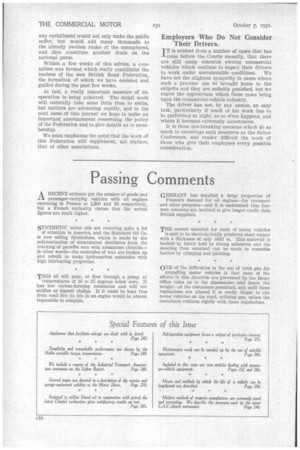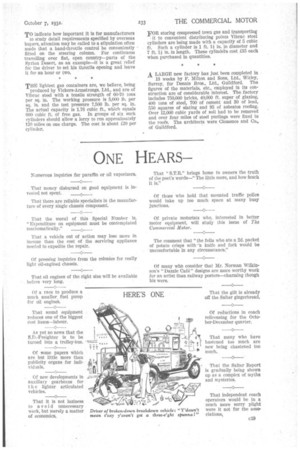Passing Comments
Page 68

Page 69

If you've noticed an error in this article please click here to report it so we can fix it.
ARECENT estimate put the number of goods and passenger-carrying vehicles with oil engines operating in France at 1,200 and 30 respectively, but a French authority claims that the actual figures are much higher.
SYNTHETIC motor oils are receiving quite a lot of attention in America, and the Standard Oil Co. is now selling Syntholube, which is made by the polymerization of unsaturated distillates from the cracking of paraffin wax with aluminium chloride— in other words—the molecules of wax are broken up and rebuilt to make hydrocarbon molecules with high lubricating properties.
THIS oil will pour, or flow through a pump, at temperatures of 20 to 25 degrees below zero. It has low carbon-forming tendencies and will not oxidize or deposit sludge. If it could be kept free from road dirt its life in an engine would be almost Impossible to compute. GERAIA_NY has supplied a large proportion of
France's demand for oil engines—for transport and other -purposes—and it is understood that German concerns are inclined to give longer credit than British suppliers.
THE newest material for roofs of motor vehicles is said to be electrolytically produced sheet copper with a thickness of only .0017 in. This material is backed by fabric held by strong adhesives and the sheeting thus obtained can be made to resemble leather by crimping and painting.
ONE of the difficulties in the use of town gas for propelling motor vehicles is that most of the efforts in this direction are prevented by the Home Office rules as to the dimensions—and hence the weight—of the containers permitted, and until these regulations are altered it is really illegal to run motor vehicles on the road, utilizing gas, unless the containers conform rigidly with these regulations.
TO indicate how important it is for manufacturers to study detail requirements specified by overseas buyers, attention may be called to a stipulation often made that a hand-throttle control be conveniently fitted on the steering column. For continuous travelling over flat, open country—parts of the Syrian Desert, as an example—it is a great relief for the driver to set his throttle opening and leave it for an hour or two.
THE lightest gas containers are, we believe, being produced by Vickers-Armstrongs, Ltd., and are of Vibrac steel with a tensile strength of 60-70 tons per sq. in. The working pressure is 5,000 lb. per sq. in. and the test pressure 7,500 lb. per sq. in. The actual capacity is 1.76 cubic ft., which equals 600 cubic ft. of free gas. In groups of six such cylinders should allow a lorry to run approximately 120 miles on one charge. The cost is about £20 per cylinder. FOR storing compressed town gas and transporting it to convenient distributing points Vibrac steel cylinders are being made with a capacity of 5 cubic ft. Such a cylinder is 1 ft. 1i in. in diameter and 7 ft. 1 in. in length. These cylindes cost £35 each when purchased in quantities.
A LARGE new factory has just been completed in 13 weeks by F. Milton and Sons, Ltd., Witley, Surrey, for Dennis Bros., Ltd., Guildford. The figures of the materials, etc., employed in its construction are of considerable Interest. The, factory includes 750,000 bricks, 40,000 ft. super of glazing, 400 tons of steel, 700 of cement and 30 of lead, 550 squares of slating and 95 of asbestos roofing. Over 12,000 cubic yards of soil had to be removed and over four miles of steel purlings were fixed to the roofs. The architects were Clemence and Co., of Guildford.




































































































































































